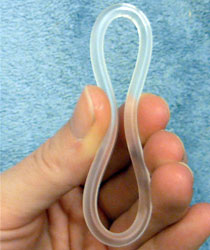For years, condoms were the only known contraceptive that protected against both HIV and pregnancy. However, condoms have a failure rate of 14-15% and their use places greater responsibility on males. Other popular contraceptives, such as oral contraceptives and patches, are effective at preventing pregnancy but not HIV transmission. Wouldn’t it be great if there was a contraceptive that protects against both HIV and pregnancy? Well, there is! Introducing the new intravaginal ring!

Image from Wikimedia Commons
Biomedical engineer Patrick Kiser from Northwestern University has constructed a one-of-a-kind vaginal ring that prevents HIV transmission, herpes, and pregnancy by discharging an antiretroviral drug and contraceptive. The ring is used like any other vaginal ring, but instead of releasing the hormones progestin and estrogen, it releases tenofovir (an antiretroviral drug) and levonorgestrel (a contraceptive). Also, unlike other intravaginal rings, this new ring requires a replacement only every three months rather than every three weeks, which is much more convenient for women.
This vaginal ring is the same size as other rings on the market, but its design is more intricate. It took Kiser and his colleagues five meticulous years to design the ring. One of the most difficult parts of the process was producing the materials that make up the ring. The portions of the ring that contain the antiretroviral drug and contraceptive are formed from two different types of polyurethanes. A third type of polyurethane is placed between the two sections to separate the drugs. Each of the polyurethanes had to be built with the right diffusion rates to ensure that the drugs would be secreted at a suitable rate. Five years worth of effort paid off, however, since the specific design of the polyurethanes allows the ring to be sturdy. The ring is also designed to swell when in contact with bodily fluids, allowing it to carry 100 times more drugs than other vaginal rings.
Another challenge Kiser and his colleagues had to deal with was the development of the mechanism to release the drugs accurately and efficiently. Tenofovir and levonorgestrel are very different from one another; tenofovir is a water soluble drug while levonorgestrel is water insoluble. The ring also has to deliver different dosages of the two drugs, with 10 milligrams and 10 micrograms of tenofovir and levonorgestrel released every day, respectively.

Tenofovir can be taken orally but the existing methods for delivering the drug in pill form aren’t as effective as using an intravaginal ring.
Thanks to the development of this new ring, women will be able to not only prevent unplanned pregnancy but sexually transmitted diseases as well. Women living in developing countries, in particular, will greatly benefit from this intravaginal ring. One-third of all pregnancies in developing countries are unintended, and these pregnancies can have serious health, financial, and cultural consequences. In addition, 95% of those living with HIV reside in developing countries. If condoms and this vaginal ring are used together, sex will become safer for everyone.
– Maria Bui
References:
Clark, J.T., Kiser, P.F., Clark, M.R., Shelke, N.B., Johnson, T.J., Smith, E.M., Andreasen, A.K., Nebeker, J.S., Fabian, J., and Friend, D.R. 2014. Engineering a Segmented Dual-Reservoir Polyurethane Intravaginal Ring for Simultaneous Prevention of HIV Transmission and Unwanted Pregnancy. PloS one. 9(3): e88509.
